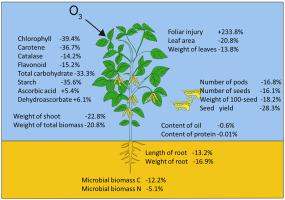Ecotoxicology and Environmental Safety ( IF 6.8 ) Pub Date : 2020-11-18 , DOI: 10.1016/j.ecoenv.2020.111644 Caihong Li , Xian Gu , Zhiyuan Wu , Tianyu Qin , Liyue Guo , Tianzuo Wang , Lu Zhang , Gaoming Jiang

|
Soybean (Glycine max) production is seriously threatened by ground-level ozone (O3) pollution. The goal of our study is to summarize the impacts of O3 on physiology, growth, yield, and quality of soybean, as well as root parameters. We performed meta-analysis on the collated 48 peer-reviewed papers published between 1980 and 2019 to quantitatively summarize the response of soybean to elevated O3 concentrations ([O3]). Relative to charcoal-filtered air (CF), elevated [O3] significantly accelerated chlorophyll degradation, enhanced foliar injury, and inhibited growth of soybean, evidenced by great reductions in leaf area (−20.8%), biomass of leaves (−13.8%), shoot (−22.8%), and root (−16.9%). Shoot of soybean was more sensitive to O3 than root in case of biomass. Chronic ozone exposure of about 75.5 ppb posed pronounced decrease in seed yield of soybean (−28.3%). In addition, root environment in pot contributes to higher reduction in shoot biomass and yield of soybean. Negative linear relationships were observed between yield loss and intensity of O3 treatment, AOT40. The larger loss in seed yield was significantly associated with higher reduction in shoot biomass and other yield component. This meta-analysis demonstrates the effects of elevated O3 on soybean were pronounced, suggesting that O3 pollution is still a soaring threat to the productivity of soybean in regions with high ozone levels.
中文翻译:

评估臭氧升高对过去40年大豆生理,生长,产量和品质的影响:荟萃分析
地面臭氧(O 3)污染严重威胁着大豆(Glycine max)的生产。我们研究的目的是总结O 3对大豆生理,生长,产量和品质以及根系参数的影响。我们对1980年至2019年间发表的48篇经同行评审的论文进行了荟萃分析,以定量总结大豆对O 3浓度升高[[O 3 ])的响应。相对于木炭过滤空气(CF),升高的[O 3]显着加速了叶绿素的降解,加剧了叶面损伤,并抑制了大豆的生长,其表现为叶面积(−20.8%),叶片生物量(−13.8%),芽(−22.8%)和根(−16.9)大大减少。 %)。在生物量的情况下,大豆的芽对O 3的敏感性比对根的敏感性更高。约75.5 ppb的长期臭氧暴露导致大豆种子产量显着下降(-28.3%)。此外,盆栽的根系环境有助于更高地减少芽生物量和大豆产量。产量损失与O 3处理强度AOT40之间呈负线性关系。种子产量的更大损失与芽生物量和其他产量成分的更高减少显着相关。这项荟萃分析证明了O升高的影响大豆上的3明显,表明在臭氧水平高的地区,O 3污染仍然是对大豆生产力的猛烈威胁。



























 京公网安备 11010802027423号
京公网安备 11010802027423号